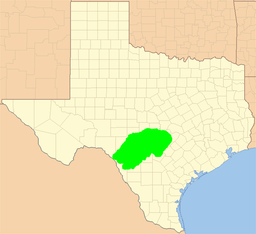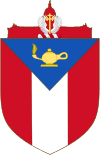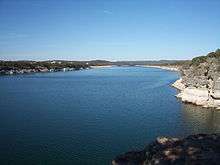Texas Hill Country
| Texas Hill Country | |
| Region | |
| Hill Country, Bandera County | |
| Country | United States |
|---|---|
| State | Texas |
| Region | Central Texas |
| Coordinates | 30°10′27″N 99°03′55″W / 30.17417°N 99.06528°WCoordinates: 30°10′27″N 99°03′55″W / 30.17417°N 99.06528°W |
| Highest point | |
| - elevation | 750 m (2,461 ft) |
| Lowest point | |
| - elevation | 300 m (984 ft) |
 Map of Texas Hill Country | |
| Website: Handbook of Texas: Hill Country | |
The Texas Hill Country is a 25-county region of Central Texas and South Texas featuring karst topography and tall rugged hills consisting of thin layers of soil atop limestone or granite.[1] It also includes the Llano Uplift and the second largest granite dome in the United States, Enchanted Rock. The Hill Country reaches into portions of the two major metropolitan areas, especially in San Antonio's northern suburbs and the western half of Travis County, ending southwest of Downtown Austin. The region is the eastern portion of the Edwards Plateau and is bound by the Balcones Fault on the east and the Llano Uplift to the west and north. The terrain is punctuated by a large number of limestone or granite rocks and boulders and a thin layer of topsoil, which makes the region very dry and prone to flash flooding. The Texas Hill Country is also home to several native types of vegetation, such as various yucca, prickly pear cactus, cedar scrub, and the dry Southwestern tree known as the Texas live oak.[2]
Several cities were settled at the base of the Balcones Escarpment, including Austin, San Marcos, and New Braunfels, as a result of springs discharging water stored in the Edwards Aquifer. The region's economy is one the fastest growing in the US.[3][4]
Counties included
According to the Texas Parks and Wildlife Department, the following 25 counties compose the Texas Hill Country:[5]
Natural features
Because of its karst topography, the area also features a number of caverns, such as Inner Space Caverns, Natural Bridge Caverns, Bracken Cave, Longhorn Cavern State Park, Cascade Caverns, Caverns of Sonora and Cave Without a Name. The deeper caverns of the area form several aquifers which serve as a source of drinking water for the residents of the area. Wonder Cave in San Marcos was formed by an earthquake along the Balcones Fault.
Several tributaries of the Colorado River of Texas — including the Llano and Pedernales rivers, which cross the region west to east and join the Colorado as it cuts across the region to the southeast – drain a large portion of the Hill Country. The Guadalupe, San Antonio, Frio, Medina, and Nueces rivers originate in the Hill Country.
This region is a dividing line for certain species occurrence. For example, the California Fan Palm (Washingtonia filifera) is the only species of palm tree that is native to the continental United States west of the Hill Country's Balcones Fault.[6]
The region has hot summers, particularly in July and August, and even the nighttime temperatures remain high, as the elevation is modest despite the hilly terrain. Winter temperatures are sometimes as much as ten degrees cooler than in other parts of Texas to the east.
 As seen from near Interstate 10.
As seen from near Interstate 10. View of the Texas Hill Country, from Garner State Park, located in Uvalde County.
View of the Texas Hill Country, from Garner State Park, located in Uvalde County.- Another scene from near Garner State Park
- Windmill in the Hill Country
 House atop hill in Texas Hill Country north of Bandera
House atop hill in Texas Hill Country north of Bandera A view of the Texas Hill Country from a rural road in Hays County
A view of the Texas Hill Country from a rural road in Hays County
In popular culture
The area is also unique for its fusion of Spanish and German influences in food, beer, architecture, and music that form a distinctively "Texan" culture separate from the state's Southern and Southwestern influences.[1] For example, the accordion was popularized in Tejano music in the 19th century due to cultural exposure to German settlers.
Devil's Backbone appeared in a 1996 episode of NBC's Robert Stack anthology series, Unsolved Mysteries, featuring ghosts of Spanish monks, Comanche as well as Lipan Apache Native Americans, Confederate soldiers on their horses, and a spirit of a wolf. It later re-aired when this series was hosted by Dennis Farina.
The region has emerged as the center of the Texas wine industry. Three American Viticultural Areas are located in the areas: Texas Hill Country AVA, Fredericksburg in the Texas Hill Country AVA, and Bell Mountain AVA.
The Hill Country is also known for its tourism. In 2008, The New York Times listed the Hill Country in an article about North American vacation destinations.[7] Hill Country has also made Texas second to Florida as the most popular retirement destination in the United States. The region has attracted Baby Boomers as they near retirement age.[8]
Frederick Day, a demographer with Texas State University, said that the Hill Country life-style reminds one of the small towns of the recent past. "Like old America . . . [the] cost of living is pretty low. To people who have spent their work life in Houston or Dallas, the Hill Country is very attractive."[8]
Notable people
| Name | Birth–Death | Notes |
|---|---|---|
| Lance Armstrong | (1971– ) | Professional cyclist renowned for seven consecutive Tour de France wins after surviving cancer. He was recently stripped of his seven Tour de France titles over a doping controversy. Born in Plano but a long-time resident of Austin. |
| Buffalo Hump | (c1790s–1800s – 1870) | War Chief of the Penateka band of the Comanche. |
| Liz Carpenter | (1920–2010) | Journalist, author, political speech writer, humorist, public speaker, first female Vice President of University of Texas student body. One of the founders of National Women's Political Caucus and co-chair of ERAmerica, traveling the country to push for passage of the Equal Rights Amendment. Drafted President Johnson's Nov 22, 1963 speech to the American public after the assassination of John F. Kennedy. |
| Jody Conradt | (1941– ) | Retired women's basketball head coach inducted into the Basketball Hall of Fame in 1998 & Women's Basketball Hall of Fame in 1999. Texas Women's Hall of Fame 1986. Born in Goldthwaite, Texas resides in Austin. First women's basketball collegiate coach to reach 700 career victories. Achieved 99% graduation rate for the students on her teams. |
| Hondo Crouch | (1916–1976) | Humorist, proprietor of Fredericksburg-adjacent Luckenbach, Texas where the town's motto is Everybody's Somebody'Waylon Jennings and Willie Nelson memorialized the small town in their song Luckenbach, Texas/Back to the Basics of Love.'[9][10] |
| Michael Dell | (1965– ) | Founder of Dell computers. Started company in Austin and still resides there. |
| John Henry Faulk | (1913–1990) | Austin-based radio personality, author, playwright, folklorist, actor, lecturer, blacklisted during the 1950s |
| Kinky Friedman | (1944– ) | American singer, songwriter, novelist, humorist, politician and columnist. Born in Chicago but grew up in Austin. Resides at Echo Hill Ranch near Kerrville. Founded Utopia Animal Rescue Ranch, also located near Kerrville |
| Fred Gipson | (1908–1973) | Novelist who authored Old Yeller, Savage Sam, and Hound Dog Man, lived in Mason |
| Trey Hardee | (1984–) | World Champion Decathlete and graduate of the University of Texas at Austin |
| Harvey Hilderbran | (1960– ) | State Representative from the western Hill Country since 1989, a Republican from Kerrville. |
| Max Hirsch | (1880–1969) | National Museum of Racing and Hall of Fame thoroughbred horse trainer |
| Betty Holekamp | (1826–1902) | German Texas pioneer, also called the Betsy Ross of Texas |
| Carl Hoppe | (1897–1981) | San Antonio artist who painted scenes of the Texas Hill Country |
| J. Marvin Hunter | (1880–1957) | Born Loyal Valley author, journalist, and historian of the American West, founded Frontier Times magazine and Frontier Times Museum in Bandera. |
| Molly Ivins | (1944–2007) | Political author, journalist, humorist from Austin |
| Lady Bird Johnson | (1912–2007) | First Lady of the United States, Graduate of University of Texas in Austin. Business woman and one-time owner of KTBC radio and television stations turned $17,500 investment into more than $150 million. She bankrolled her husband's initial political career, buried in Stonewall, Texas next to husband Lyndon B. Johnson. Lady Bird Johnson Wildflower Center is named for her decades-long project to beautify America's landscapes |
| Lyndon B. Johnson | (1908–1973) | President of the United States, born and raised in Stonewall, Texas. |
| Tommy Lee Jones | (1946–) | Actor, born in San Saba. |
| Robert Earl Keen | (1956–) | Country singer-songwriter, former resident of Bandera, Texas and current resident of Kerrville, Texas |
| Guich Koock | (1944– ) | Actor, humorist, one-time owner of Luckenbach, Texas, Fredericksburg businessman, nephew of John Henry Faulk.[11][12] |
| Herman Lehmann | (1859–1932) | Apache captive and then Comanche adoptee (adopted son of Chief Quanah Parker), native of Loyal Valley, 1927 autobiography, Nine Years Among the Indians |
| Hermann Lungkwitz | (1813–1891) | Romantic landscape artist and photographer, noted for first pictoral records of the Texas Hill Country |
| Gerald Lyda | (1923–2005) | General contractor and cattle rancher, born and raised in the Hill Country community of Marble Falls |
| Johnny Manziel | Also known as Johnny Football, the first freshman to win Heisman trophy and quarterback for the Fightin' Texas Aggies is from Kerrville | |
| Matthew McConaughey | (1969– ) | Model/Actor, raised in Uvalde, Texas attended The University of Texas at Austin |
| John O. Meusebach | (1812–1897) | Founder of Fredericksburg negotiated 1847 Meusebach-Comanche Treaty (unbroken to this date) with Comanche chiefs Buffalo Hump, Santa Anna, Old Owl. Oversaw development of New Braunfels. Elected Texas State Senator for Bexar, Comal and Medina Counties. Buried Marschall-Meusebach Cemetery in Loyal Valley |
| Willie Hugh Nelson | (1933– ) | American country singer-songwriter, author, poet, actor and activist. Austin resident |
| Elisabet Ney | (1833–1907) | Sculptor, art pioneer, works can be found in the Smithsonian American Art Museum, Texas State Capitol, U.S. Capitol |
| James Wilson Nichols | (1820–1891) | Texas Ranger, Frontier Battalion, Indian Scout, author, Now You Hear My Horn. Buried Kerrville.[13][14] |
| Chester W. Nimitz | (1885–1966) | Commander of U.S. Naval forces in the Pacific during World War II was from Fredericksburg and Kerrville |
| Old Owl | (c1790s – 1849) | Civil Chief of the Penateka band of the Comanche Indians |
| Alfred P.C. Petsch | (1887–1981) | Lawyer, legislator, civic leader, and philanthropist. Served in the Texas House of Representatives 1925–1941. Veteran of both World War I and World War II.[15] |
| Ann Richards | (1933–2006) | Governor of Texas (1991–1995). Resided in Austin. |
| Rudy Robbins | (1933– ) | Singer, songwriter, actor, stuntman from Bandera |
| Andy Roddick | (1982– ) | Former professional tennis player who resides in Austin. |
| Santa Anna | (c1790s – 1849) | War Chief of the Penateka band of the Comanche Indians |
| Robert F. "Bob" Schenkkan | (1917-2011) | Teacher, radio and TV broadcaster, professor of communications. A long-time Austin resident, was instrumental in founding PBS and an USAID consultant.[16][17] |
| Charles Schreiner, Sr. | (1838-1927) | Businessman, banker, rancher, landholder, philanthropist in Kerrville[18] |
| Charles Schreiner, III | (1927-2001) | Rancher and businessman from Kerr County, who worked to preserve the Texas Longhorn cattle from extinction[19] |
| Juan Nepomuceno Seguín | (1806–1890) | Served on both sides during the Texas Revolution. Fought with Sam Houston and organized a Tejano rear guard. 1834 Territorial Governor of Texas, 1841 Mayor of San Antonio. Suspicions of his loyalty caused him to flee to Mexico in 1842. Served with Mexico's General Adrian Woll and participated in Woll's 1842 invasion of Texas. Seguin, Texas named in his honor.[14][20][21] |
| Sixpence None the Richer | An alternative rock band prominent in the late 1990s with their song "Kiss Me" | |
| Frank Van der Stucken | (1858–1929) | Music composer, conductor[22] |
| Stevie Ray Vaughan | (1954–1990) | Blues guitar player resided in Austin. |
See also
- Adelsverein
- Balcones Canyonlands National Wildlife Refuge
- Cherry Springs Dance Hall
- German Texan
- List of geographical regions in Texas
- Mount Bonnell
- Revolutions of 1848
References
- 1 2 Jordan, Terry G. "Hill Country". Handbook of Texas Online. Retrieved 7 November 2009.
- ↑ Lehman, Roy L.; Ruth O'Brien; Tammy White (2005). Plants of the Texas Coastal Bend. Texas A&M University Press. ISBN 978-1-58544-408-3.
- ↑ "America's Next Great Metropolis Is Taking Shape In Texas". Forbes. October 13, 2016. Retrieved October 17, 2016.
- ↑ http://www.texasmonthly.com/the-culture/austin-and-the-city-of-the-eternal-boom/
- ↑ Texas Parks and Wildlife. "Hill Country Wildlife Management". Land & Water: Habitats. Retrieved 5 April 2010.
- ↑ Hogan, C. Michael (2009-01-05). Nicklas Stromberg, ed. "California Fan Palm: Washingtonia filifera". GlobalTwitcher.com. Retrieved 2009-07-18.
- ↑ "31 Places to Go This Summer". New York Times. 1 June 2008. Retrieved 11 January 2012.
- 1 2 Bobbi Gage, "Baby boomers being drawn to Hill Country", Llano County Journal, July 2, 2008, pp. 1, 7A
- ↑ Patterson, Becky Crouch. "Crouch, John Russell (Hondo)". Handbook of Texas Online. Texas State Historical Association. Retrieved 13 November 2010.
- ↑ "History of Luckenbach". Luckenbach, Texas. Retrieved 13 November 2010.
- ↑ "Koock, Guich Bio". IMDb. Retrieved 13 November 2010.
- ↑ Hallowell, John. "Guich Koock". Texas Hill Country Magazine (Fall 2009).
- ↑ Schellenberg, Cynthia. "Nichols, James Wilson". Handbook of Texas Online. Texas State Historical Association. Retrieved 13 November 2010.
- 1 2 McKeehan, Wallace L. "The Battle of Salado The Journal of James Wilson Nichols 1820–1887". Sons of DeWitt Colony Texas. Retrieved 13 November 2010.
- ↑ Watkins, Melanie. "Petsch, Alfred PC". Handbook of Texas Online. Texas State Historical Association. Retrieved 17 November 2010.
- ↑ http://current.org/files/archive-site/obituaries/obit1104schenkkan.html
- ↑ http://www.legacy.com/obituaries/statesman/obituary.aspx?pid=148529709
- ↑ Hollon, W. Eugene. "TSHA: Schreiner, Charles Armand". Handbook of Texas Online. Texas State Historical Association. Retrieved October 15, 2015.
- ↑ Douglas Martin (April 29, 2001). "Charles Schreiner III, 74, Dies; Colorful Texas Rancher Fought to Save Longhorn". New York Times. Retrieved October 16, 2015.
- ↑ de la Teja, Jesús F. "Seguin, Juan Nepomuceno". Handbook of Texas Online. Texas State Historical Association. Retrieved 13 November 2010.
- ↑ "Col. Juan N. Seguin". Seguin Descendants Historical Preservation. Retrieved 13 November 2010.
- ↑ Wolz, Larry. "Van Der Stucken, Frank Valentine". Handbook of Texas Online. Texas State Historical Association. Retrieved 17 November 2010.
External links
| Wikimedia Commons has media related to Texas Hill Country. |


